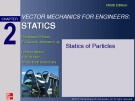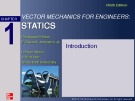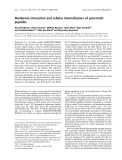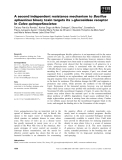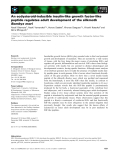
Vector mechanics
-
The objective for the current chapter is to investigate the effects of forces on particles: replacing multiple forces acting on a particle with a single equivalent or resultant force, relations between forces acting on a particle that is in a state of equilibrium.
 32p
32p  thieugialam101
thieugialam101
 30-03-2015
30-03-2015
 63
63
 6
6
 Download
Download
-
Mechanics is the science which describes and predicts the conditions of rest or motion of bodies under the action of forces.
 8p
8p  thieugialam101
thieugialam101
 30-03-2015
30-03-2015
 67
67
 6
6
 Download
Download
-
Penetratin is a 16-residue peptide [RQIKIWFQNRRM KWKK(43–58)]derived from the Antennapedia homeo-domain, which is used as a vector for cellular internalization of hydrophilic molecules. In order to unravel themembrane translocation mechanism, we synthesized new penetratin variants. The contribution of the positively charged residues was studied by double substitutions of Lys and/or Arg resi-dues to Ala, while the specific contribution of Trp48 and Trp56 was studied by individual substitution of these resi-dues to Phe. ...
 11p
11p  dell39
dell39
 03-04-2013
03-04-2013
 46
46
 4
4
 Download
Download
-
The entomopathogenBacillus sphaericusis an important tool for the vector control ofCulexsp., and its effectiveness has been validated in field trials. The appearance of resistance to this bacterium, however, remains a threat to its use, and attempts have been made to understand the resistance mech-anisms.
 13p
13p  inspiron33
inspiron33
 26-03-2013
26-03-2013
 50
50
 4
4
 Download
Download
-
In anautogenous mosquitoes, egg development requires blood feeding and as a consequence mosquitoes act as vectors of numerous devastating dis-eases of humans and domestic animals. Understanding the molecular mechanisms regulating mosquito egg development may contribute signi-ficantly to the development of novel vector-control strategies.
 12p
12p  vinaphone15
vinaphone15
 27-02-2013
27-02-2013
 38
38
 2
2
 Download
Download
-
As was done in Chapter 7 we use scalars such as work ,kinetic energy, and mechanical energy rather than vectors. Therefore the approach is mathematically simpler.
 16p
16p  kieucongviet
kieucongviet
 24-12-2009
24-12-2009
 159
159
 13
13
 Download
Download
-
This approach is alternative approach to mechanics. It uses scalars such as work and kinetic energy rather than vectors such as velocity and acceleration. Therefore it simpler to apply.
 14p
14p  kieucongviet
kieucongviet
 24-12-2009
24-12-2009
 114
114
 11
11
 Download
Download
-
In chapters 2 and 4 we have studied “kinematics” i.e. described the motion of objects using parameters such as the position vector, velocity and acceleration without any insights as to what caused the motion. This is the task of chapters 5 and 6 in which the part of mechanics known as “dynamics” will be developed. In this chapter we will introduce Newton’s three laws of motion which is at the heart of classical mechanics.
 12p
12p  kieucongviet
kieucongviet
 24-12-2009
24-12-2009
 148
148
 9
9
 Download
Download








